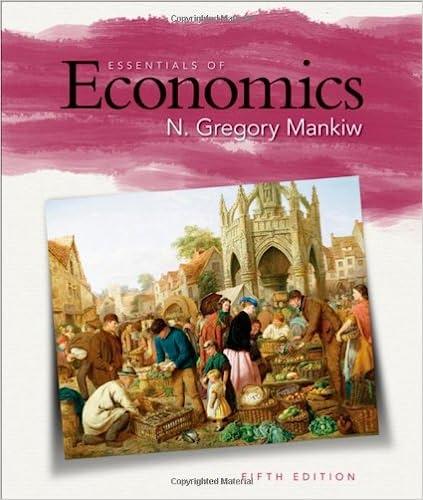Question
Problem PS5.4.1 Despondent over the Red Sox's terrible season, Prof. Gruber decides to quit his day job and start a bicycle manufacturing firm in Kendall
Problem PS5.4.1
Despondent over the Red Sox's terrible season, Prof. Gruber decides to quit his day job and start a bicycle manufacturing firm in Kendall Square. As he starts looking into the bicycle manufacturing industry, he realizes it has some interesting features. First, he realizes that it operates as a competitive industry. Second, he finds that there are two technologies used by firms in the industry. Technology 1 uses solar power, and has a cost functionC1(q)=q+4q2+32forq>0. Technology 2 uses electricity from the grid and is more efficient, with a cost functionC2(q)=q+2q2+32 forq>0. Assume that we are in the long run, so firms using both technologies can shut and leave the market at 0 cost, so thatC(0)=0 for both technologies.
Compute the marginal cost for technology 1.
MC1 (q)=
- 1+4q+32/q
- 1+8q
- 1+2q+32/q
- 1+4q
- None of the above
Compute the marginal cost for technology 2.
MC2(q)=
- 1+2q+32/q
- 1+4q
- 1+4q+32/q
- 1+8q
- None of the above
Compute the average cost for technology 1.
AC1(q)=
- 1+8q
- 1+4q
- 1+4q+32/q
- 1+2q+32/q
- None of the above
Compute the average cost for technology 2.
AC2(q)=
- 1+8q
- 1+4q+32/q
- 1+2q+32/q
- 1+4q
- None of the above
Problem PS5.4.2
Derive the supply curve for each technology.
q1(p)=
- p1/8
- 1p/8
- p1/4
- 1p/4
- None of the above
q2(p)=
- p1/4
- 1p/4
- p1/8
- 1p/8
- None of the above
Problem PS5.4.3
In the long-run, assuming that firms can choose their technology, what will happen?
- The answer depends on firms' desired level of output
- Some firms will choose the solar technology (technology 1)
- No firms will choose the solar technology (technology 1)
- All firms will choose the solar technology (technology 1)
- The answer is ambiguous
Problem PS5.4.4
Now let's pretend for a minute that only technology 2 exists. Suppose that market demand for bicycles is given byD(p)=82040p. Furthermore, assume that there is free entry for firms using technology 2.
What will be the long-run price in the market?
p*=
How much will each firm produce at this price?
q*=
What will the total number of firms be?
N=
Problem PS5.4.5
Now, suppose that the government of Massachusetts offers solar subsidies to 10 bicycle manufacturers. These subsidies are for $80 and the manufacturers receive these subsidies as long as they construct a bicycle manufacturing plant using the newly-invented solar technology (i.e. technology 1). Determine the new MC, AC, and supply curve for the solar technology with the subsidy.
MC1(q)=
- 1+4q+32/q
- 1+8q
- 1+2q48/q
- 1+4q
- None of the above
AC1(q)=
- 1+4q48/q
- 1+2q32/q
- 1+4q+48/q
- 1+2q+32/q
- None of the above
q1(p)=
- 1p/8
- p1/8
- 1p/16
- p1/16
- None of the above
Problem PS5.4.6
The long run price, now that there are 10 bicycle manufactures using technology 1, will remain atp*=17. There is still free entry for firms using technology 2.
What quantity will be produced by each firm using technology 1?
q1=
What quantity will be produced by each firm using technology 2?
q2=
In equilibrium, how many firms using technology 2 will there be in the market?
N2=
Problem PS5.4.7
In equilibrium, how much profit will each technology 1 firm make?
1=
In equilibrium, how much profit will each technology 2 firm make?
2=
Problem PS5.4.8
The long run aggregate supply curve in this market (i.e. the total amount supplied by all firms as a function of price) depends on whether the price is less than 17.
Forp<17,Qs
(p)=
- 10/8 (p1)
- 1/4 (p1)
- 1/8 (1p)
- 1/4 (1p)
- None of the above
Forp17, the long run aggregate supply curve cannot be expressed as a function of the above form. Why not?
- Because the supply becomes infinitely inelastic
- Because the supply becomes infinitely elastic
- Because there is uncertainty in the model
- None of the above
Problem PS5.4.9
Now suppose that the State of Massachusetts increases the number of solar bike manufacturing subsidies it will give from 10 to 100.
What is the new long-run price?
p*=
How much will be produced in total by firms with technology 1?
Q1=
How much will be produced by total by firms with technology 2?
Q2=
How many firms will there be with technology 1?
N1=
How many firms will there be with technology 2?
N2=
How much profit will be earned by each firm with technology 1?
1=
How much profit will be earned by each firm with technology 2?
2=
Step by Step Solution
There are 3 Steps involved in it
Step: 1

Get Instant Access to Expert-Tailored Solutions
See step-by-step solutions with expert insights and AI powered tools for academic success
Step: 2

Step: 3

Ace Your Homework with AI
Get the answers you need in no time with our AI-driven, step-by-step assistance
Get Started


